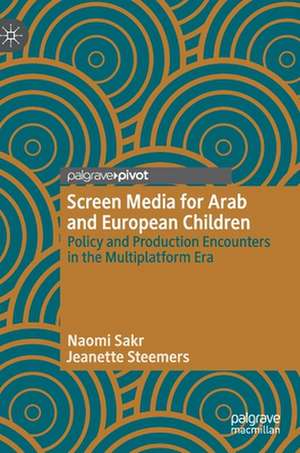Screen Media for Arab and European Children: Policy and Production Encounters in the Multiplatform Era
Autor Naomi Sakr, Jeanette Steemersen Limba Engleză Hardback – 17 oct 2019
Preț: 417.90 lei
Nou
Puncte Express: 627
Preț estimativ în valută:
79.99€ • 86.92$ • 67.24£
79.99€ • 86.92$ • 67.24£
Carte tipărită la comandă
Livrare economică 21 aprilie-05 mai
Preluare comenzi: 021 569.72.76
Specificații
ISBN-13: 9783030256579
ISBN-10: 303025657X
Pagini: 114
Ilustrații: IX, 142 p.
Dimensiuni: 148 x 210 mm
Greutate: 0.34 kg
Ediția:1st ed. 2019
Editura: Springer International Publishing
Colecția Palgrave Pivot
Locul publicării:Cham, Switzerland
ISBN-10: 303025657X
Pagini: 114
Ilustrații: IX, 142 p.
Dimensiuni: 148 x 210 mm
Greutate: 0.34 kg
Ediția:1st ed. 2019
Editura: Springer International Publishing
Colecția Palgrave Pivot
Locul publicării:Cham, Switzerland
Cuprins
1. Local, Regional and Global Media at a Time of Forced Migration: Evolving Geometries of Power.- 2. Joining the Dots: How Arab and European Children are Connected by Screen Media.- 3. Towards Well-Being? Stimuli for Shared Practice on Policy and Regulation.- 4. Face-to-Face: Cross-Cultural Collaboration in Provision and Delivery.- 5. Arab Children in Europe: Managing Diversity on Children’s Television.- 6. Children’s Visibility as Stakeholders: From Provision to Participation.
Notă biografică
Naomi Sakr is Professor of Media Policy at the Communication and Media Research Institute, University of Westminster, UK. She is the author of three books about Arab media, editor of two others, and co-editor of two, including Children’s TV and Digital Media in the Arab World with Jeanette Steemers (2017).
Jeanette Steemers is Professor of Culture, Media and Creative Industries at King’s College London, UK. She has published widely on European media industries and media policy, including numerous articles and a book on children's media industries. Before becoming an academic she worked in children’s television distribution.
Textul de pe ultima copertă
This book addresses gaps in our understanding of processes that underpin the making and circulation of children's screen contents across the Arab region and Europe. Taking account of recent disruptive shifts in geopolitics that call for new thinking about how children’s media policy and production should proceed after large-scale forced migration in both regions, the book asks to what extent children in Europe and the Arab World are engaging with the same content. Who is funding new content and who is making it, according to whose criteria? Whose voices are loudest when it comes to pressures for regulation of children’s screen content, and what exactly do they want? The answers to these questions matter for anyone seeking insights into diverse cross-cultural collaborations and content innovations that are shaping new investment and production relationships.
Caracteristici
Compares the production and flow of children’s screen content in two regions, whilst also analysing collaborations and connections between them Adopts a children-centric perspective that considers children participating in media production and decision-making processes Examines the impact of regional geopolitics and the large-scale displacement of children in European and Arab countries
